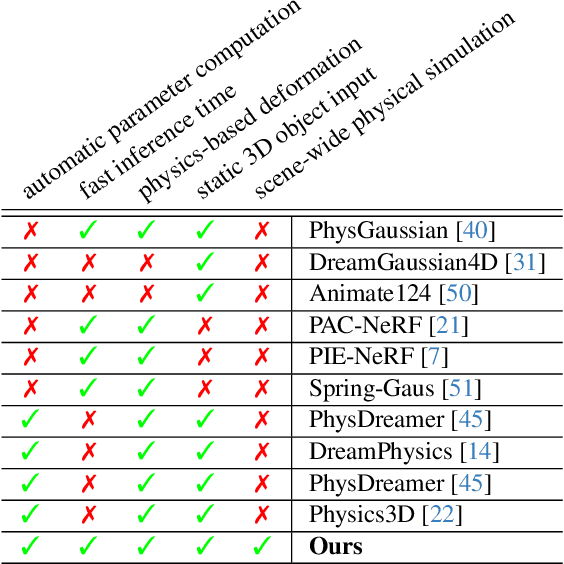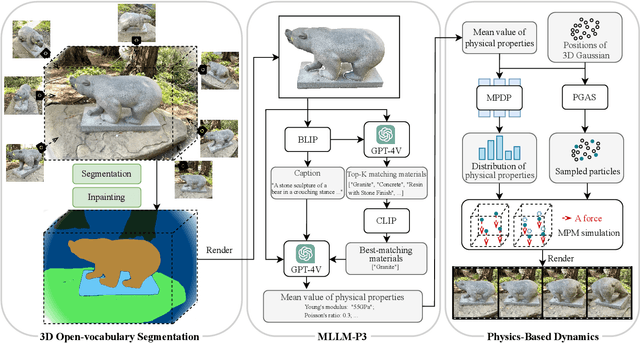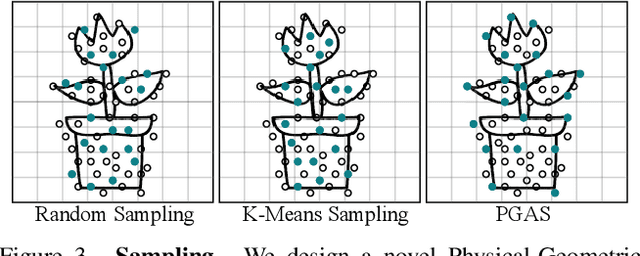Zhiyu Wu
The ML.ENERGY Benchmark: Toward Automated Inference Energy Measurement and Optimization
May 09, 2025Abstract:As the adoption of Generative AI in real-world services grow explosively, energy has emerged as a critical bottleneck resource. However, energy remains a metric that is often overlooked, under-explored, or poorly understood in the context of building ML systems. We present the ML.ENERGY Benchmark, a benchmark suite and tool for measuring inference energy consumption under realistic service environments, and the corresponding ML.ENERGY Leaderboard, which have served as a valuable resource for those hoping to understand and optimize the energy consumption of their generative AI services. In this paper, we explain four key design principles for benchmarking ML energy we have acquired over time, and then describe how they are implemented in the ML.ENERGY Benchmark. We then highlight results from the latest iteration of the benchmark, including energy measurements of 40 widely used model architectures across 6 different tasks, case studies of how ML design choices impact energy consumption, and how automated optimization recommendations can lead to significant (sometimes more than 40%) energy savings without changing what is being computed by the model. The ML.ENERGY Benchmark is open-source and can be easily extended to various customized models and application scenarios.
Tempo: Application-aware LLM Serving with Mixed SLO Requirements
Apr 24, 2025



Abstract:The integration of Large Language Models (LLMs) into diverse applications, ranging from interactive chatbots and cloud AIOps to intelligent agents, has introduced a wide spectrum of Service Level Objectives (SLOs) for responsiveness. These workloads include latency-sensitive requests focused on per-token latency in streaming chat, throughput-intensive requests that require rapid full responses to invoke tools, and collective requests with dynamic dependencies arising from self-reflection or agent-based reasoning. This workload diversity, amplified by unpredictable request information such as response lengths and runtime dependencies, makes existing schedulers inadequate even within their design envelopes. In this paper, we define service gain as the useful service delivered by completing requests. We observe that as SLO directly reflects the actual performance needs of requests, completing a request much faster than its SLO (e.g., deadline) yields limited additional service gain. Based on this insight, we introduce Tempo, the first systematic SLO-aware scheduler designed to maximize service gain across diverse LLM workloads. Tempo allocates just enough serving bandwidth to meet each SLO, maximizing residual capacity for others best-effort workloads. Instead of assuming request information or none at all, it adopts a hybrid scheduling strategy: using quantile-based response upper bounds and dependency-graph matching for conservative initial estimates, prioritizing requests by service gain density, and refining decisions online as generation progresses. Our evaluation across diverse workloads, including chat, reasoning, and agentic pipelines, shows that Tempo improves end-to-end service gain by up to 8.3$\times$ and achieves up to 10.3$\times$ SLO goodput compared to state-of-the-art designs
Janus-Pro: Unified Multimodal Understanding and Generation with Data and Model Scaling
Jan 29, 2025Abstract:In this work, we introduce Janus-Pro, an advanced version of the previous work Janus. Specifically, Janus-Pro incorporates (1) an optimized training strategy, (2) expanded training data, and (3) scaling to larger model size. With these improvements, Janus-Pro achieves significant advancements in both multimodal understanding and text-to-image instruction-following capabilities, while also enhancing the stability of text-to-image generation. We hope this work will inspire further exploration in the field. Code and models are publicly available.
DeepSeek-V3 Technical Report
Dec 27, 2024



Abstract:We present DeepSeek-V3, a strong Mixture-of-Experts (MoE) language model with 671B total parameters with 37B activated for each token. To achieve efficient inference and cost-effective training, DeepSeek-V3 adopts Multi-head Latent Attention (MLA) and DeepSeekMoE architectures, which were thoroughly validated in DeepSeek-V2. Furthermore, DeepSeek-V3 pioneers an auxiliary-loss-free strategy for load balancing and sets a multi-token prediction training objective for stronger performance. We pre-train DeepSeek-V3 on 14.8 trillion diverse and high-quality tokens, followed by Supervised Fine-Tuning and Reinforcement Learning stages to fully harness its capabilities. Comprehensive evaluations reveal that DeepSeek-V3 outperforms other open-source models and achieves performance comparable to leading closed-source models. Despite its excellent performance, DeepSeek-V3 requires only 2.788M H800 GPU hours for its full training. In addition, its training process is remarkably stable. Throughout the entire training process, we did not experience any irrecoverable loss spikes or perform any rollbacks. The model checkpoints are available at https://github.com/deepseek-ai/DeepSeek-V3.
DeepSeek-VL2: Mixture-of-Experts Vision-Language Models for Advanced Multimodal Understanding
Dec 13, 2024



Abstract:We present DeepSeek-VL2, an advanced series of large Mixture-of-Experts (MoE) Vision-Language Models that significantly improves upon its predecessor, DeepSeek-VL, through two key major upgrades. For the vision component, we incorporate a dynamic tiling vision encoding strategy designed for processing high-resolution images with different aspect ratios. For the language component, we leverage DeepSeekMoE models with the Multi-head Latent Attention mechanism, which compresses Key-Value cache into latent vectors, to enable efficient inference and high throughput. Trained on an improved vision-language dataset, DeepSeek-VL2 demonstrates superior capabilities across various tasks, including but not limited to visual question answering, optical character recognition, document/table/chart understanding, and visual grounding. Our model series is composed of three variants: DeepSeek-VL2-Tiny, DeepSeek-VL2-Small and DeepSeek-VL2, with 1.0B, 2.8B and 4.5B activated parameters respectively. DeepSeek-VL2 achieves competitive or state-of-the-art performance with similar or fewer activated parameters compared to existing open-source dense and MoE-based models. Codes and pre-trained models are publicly accessible at https://github.com/deepseek-ai/DeepSeek-VL2.
Automated 3D Physical Simulation of Open-world Scene with Gaussian Splatting
Nov 19, 2024



Abstract:Recent advancements in 3D generation models have opened new possibilities for simulating dynamic 3D object movements and customizing behaviors, yet creating this content remains challenging. Current methods often require manual assignment of precise physical properties for simulations or rely on video generation models to predict them, which is computationally intensive. In this paper, we rethink the usage of multi-modal large language model (MLLM) in physics-based simulation, and present Sim Anything, a physics-based approach that endows static 3D objects with interactive dynamics. We begin with detailed scene reconstruction and object-level 3D open-vocabulary segmentation, progressing to multi-view image in-painting. Inspired by human visual reasoning, we propose MLLM-based Physical Property Perception (MLLM-P3) to predict mean physical properties of objects in a zero-shot manner. Based on the mean values and the object's geometry, the Material Property Distribution Prediction model (MPDP) model then estimates the full distribution, reformulating the problem as probability distribution estimation to reduce computational costs. Finally, we simulate objects in an open-world scene with particles sampled via the Physical-Geometric Adaptive Sampling (PGAS) strategy, efficiently capturing complex deformations and significantly reducing computational costs. Extensive experiments and user studies demonstrate our Sim Anything achieves more realistic motion than state-of-the-art methods within 2 minutes on a single GPU.
JanusFlow: Harmonizing Autoregression and Rectified Flow for Unified Multimodal Understanding and Generation
Nov 12, 2024Abstract:We present JanusFlow, a powerful framework that unifies image understanding and generation in a single model. JanusFlow introduces a minimalist architecture that integrates autoregressive language models with rectified flow, a state-of-the-art method in generative modeling. Our key finding demonstrates that rectified flow can be straightforwardly trained within the large language model framework, eliminating the need for complex architectural modifications. To further improve the performance of our unified model, we adopt two key strategies: (i) decoupling the understanding and generation encoders, and (ii) aligning their representations during unified training. Extensive experiments show that JanusFlow achieves comparable or superior performance to specialized models in their respective domains, while significantly outperforming existing unified approaches across standard benchmarks. This work represents a step toward more efficient and versatile vision-language models.
Janus: Decoupling Visual Encoding for Unified Multimodal Understanding and Generation
Oct 17, 2024



Abstract:In this paper, we introduce Janus, an autoregressive framework that unifies multimodal understanding and generation. Prior research often relies on a single visual encoder for both tasks, such as Chameleon. However, due to the differing levels of information granularity required by multimodal understanding and generation, this approach can lead to suboptimal performance, particularly in multimodal understanding. To address this issue, we decouple visual encoding into separate pathways, while still leveraging a single, unified transformer architecture for processing. The decoupling not only alleviates the conflict between the visual encoder's roles in understanding and generation, but also enhances the framework's flexibility. For instance, both the multimodal understanding and generation components can independently select their most suitable encoding methods. Experiments show that Janus surpasses previous unified model and matches or exceeds the performance of task-specific models. The simplicity, high flexibility, and effectiveness of Janus make it a strong candidate for next-generation unified multimodal models.
MathScape: Evaluating MLLMs in multimodal Math Scenarios through a Hierarchical Benchmark
Aug 15, 2024Abstract:With the development of Multimodal Large Language Models (MLLMs), the evaluation of multimodal models in the context of mathematical problems has become a valuable research field. Multimodal visual-textual mathematical reasoning serves as a critical indicator for evaluating the comprehension and complex multi-step quantitative reasoning abilities of MLLMs. However, previous multimodal math benchmarks have not sufficiently integrated visual and textual information. To address this gap, we proposed MathScape, a new benchmark that emphasizes the understanding and application of combined visual and textual information. MathScape is designed to evaluate photo-based math problem scenarios, assessing the theoretical understanding and application ability of MLLMs through a categorical hierarchical approach. We conduct a multi-dimensional evaluation on 11 advanced MLLMs, revealing that our benchmark is challenging even for the most sophisticated models. By analyzing the evaluation results, we identify the limitations of MLLMs, offering valuable insights for enhancing model performance.
AllMatch: Exploiting All Unlabeled Data for Semi-Supervised Learning
Jun 22, 2024



Abstract:Existing semi-supervised learning algorithms adopt pseudo-labeling and consistency regulation techniques to introduce supervision signals for unlabeled samples. To overcome the inherent limitation of threshold-based pseudo-labeling, prior studies have attempted to align the confidence threshold with the evolving learning status of the model, which is estimated through the predictions made on the unlabeled data. In this paper, we further reveal that classifier weights can reflect the differentiated learning status across categories and consequently propose a class-specific adaptive threshold mechanism. Additionally, considering that even the optimal threshold scheme cannot resolve the problem of discarding unlabeled samples, a binary classification consistency regulation approach is designed to distinguish candidate classes from negative options for all unlabeled samples. By combining the above strategies, we present a novel SSL algorithm named AllMatch, which achieves improved pseudo-label accuracy and a 100\% utilization ratio for the unlabeled data. We extensively evaluate our approach on multiple benchmarks, encompassing both balanced and imbalanced settings. The results demonstrate that AllMatch consistently outperforms existing state-of-the-art methods.
 Add to Chrome
Add to Chrome Add to Firefox
Add to Firefox Add to Edge
Add to Edge